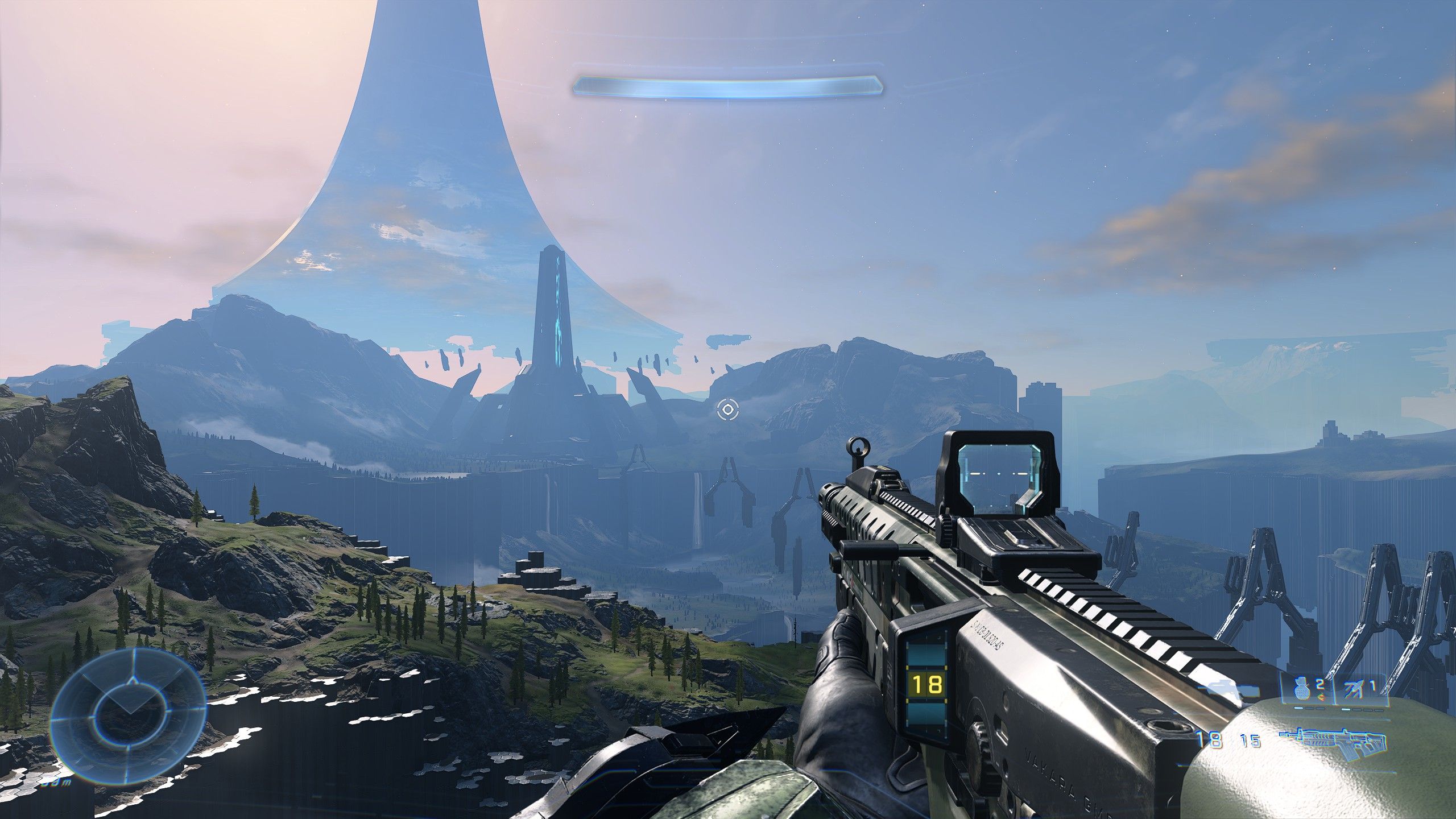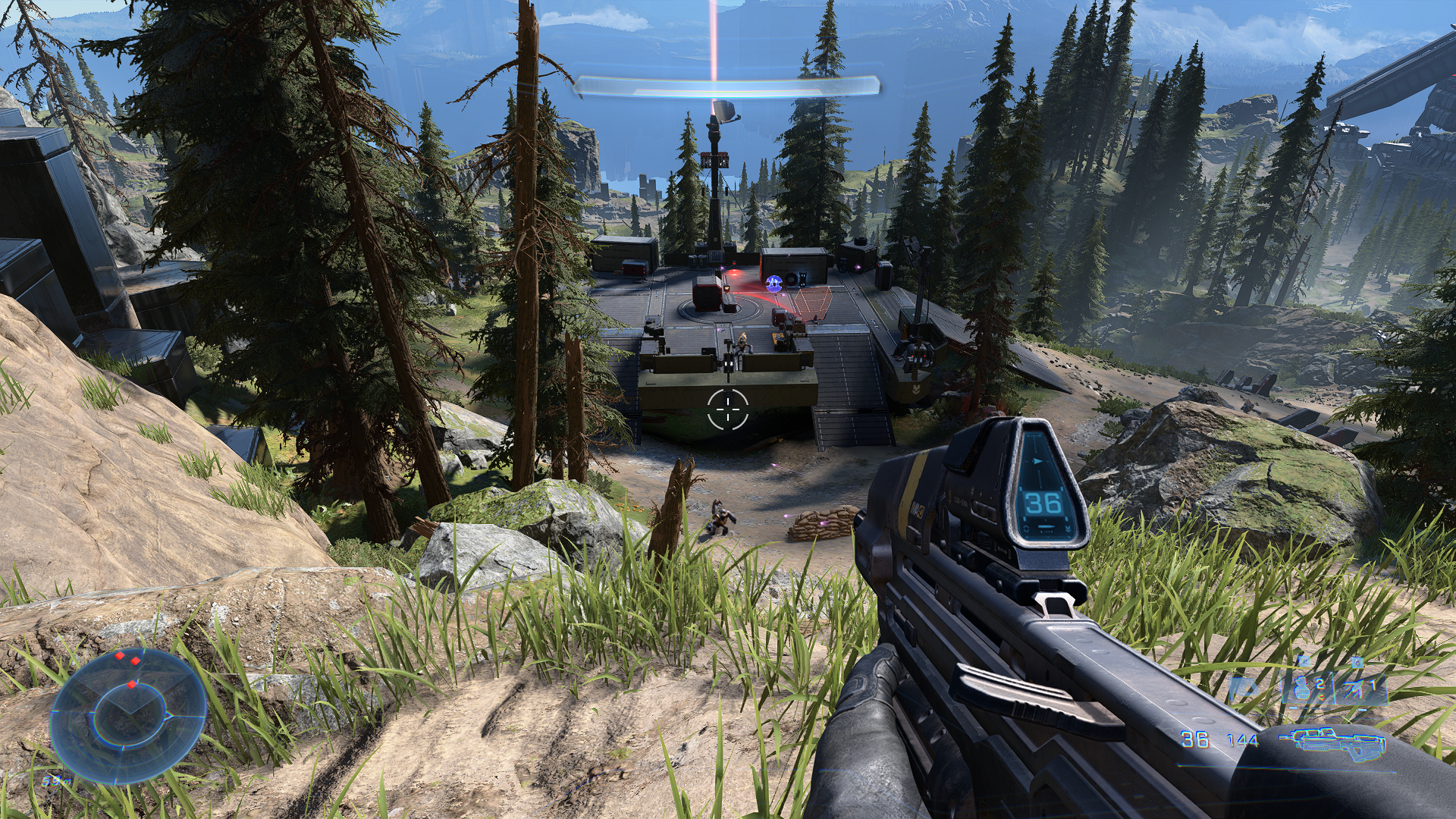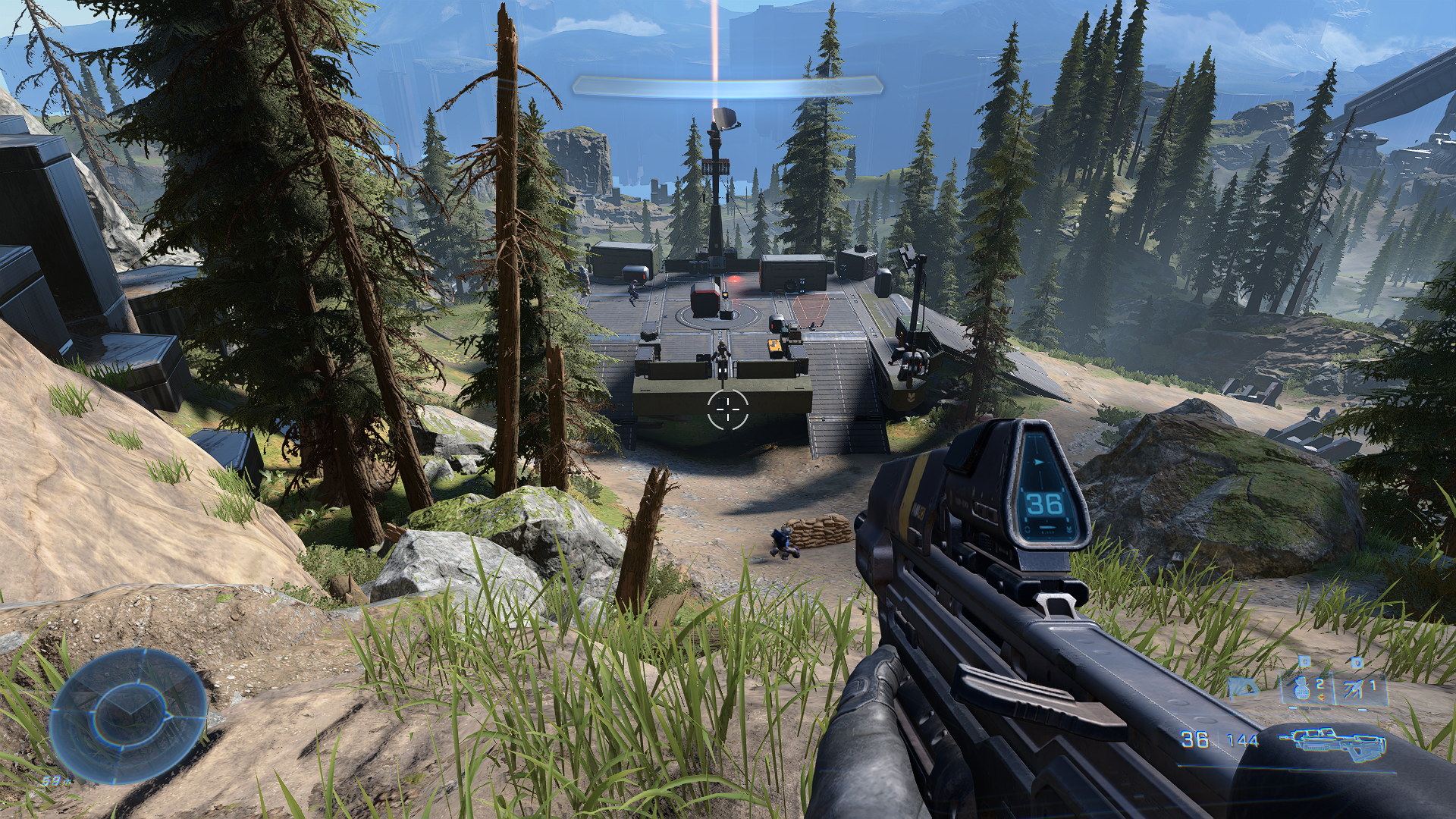The testing aspect of this is going to focus on the campaign, which I know many people won’t pump the hours into as they might flipping jeeps in multiplayer. But having played both, lemme tell ya: the new, semi-open world sections of Halo Infinite’s campaign will make your hardware sweat more profusely than any multiplayer map or mode. By finding the specs and settings that produce smooth frame rates in the solo adventure, then, you’re effectively guaranteeing yourself good multiplayer performance in the process.
Halo Infinite PC system requirements
First, though, let’s consider what developers 343 Industries reckon you’ll need inside your rig.
Halo Infinite Low quality/minimum PC specs
OS: Windows 10 October 2018 Update CPU: AMD Ryzen 5 1600 / Intel Core i5-4440 GPU: AMD Radeon RX 570 / Nvidia GTX 1050 Ti VRAM: 4GB+ RAM: 8GB+ Storage: 50GB+
Halo Infinite Medium quality PC specs
OS: Windows 10 November 2019 Update CPU: AMD Ryzen 5 2600 / Intel Core i5-9500 GPU: AMD Radeon RX 5500 XT / Nvidia GeForce GTX 1660 VRAM: 6GB+ RAM: 8GB+ Storage: 50GB+
Halo Infinite High quality/recommended PC specs
OS: Windows 10 November 2019 Update CPU: AMD Ryzen 7 3700X / Intel Core i7-9700K GPU: AMD Radeon RX 5700 XT / Nvidia GeForce RTX 2070 VRAM: 8GB+ RAM: 16GB+ Storage: 50GB+
Halo Infinite Ultra quality PC specs
OS: Windows 10 November 2019 Update CPU: AMD Ryzen 9 5900X / Intel Core i9-11900K GPU: AMD Radeon RX 6800XT / Nvidia GeForce RTX 3080 VRAM: 10GB+ RAM: 16GB+ Storage: 50GB+
No big, nasty surprises here, except maybe the suggestion of at least 10GB of video memory for Ultra quality. Though having conducted all my testing with an Intel Core i5-11600K and an 8GB RTX 3070, it does seem like you can get away with less, even at 4K. That said, I do wish Halo Infinite scaled a little better on higher-end hardware. With the Ultra preset, a solid 144Hz proved elusive to me, even playing at 1080p and on the dinkiest close-quarters multiplayer maps. It’s easy to stay above 60fps if you’re happy with that level, though if you’ve pimped your rig out with one of the best gaming CPUs and one of the best graphics cards, you may still need to make some tactical settings changes to maintain the highest frame rates.
Halo Infinite best settings guide
While Halo Infinite lacks more luxurious PC extras like DLSS or ray tracing, it is teeming with fine-tuneable graphical settings. Not counting the presets – Ultra, High, Medium, and Low – there are a solid 20 individual settings to tangle with, as well as options for limiting frame rate, adding a sharpening filter or even toggling those little anime speed lines that appear when sprinting. Let’s start with the presets. Using my RTX 3070 test rig, 1080p resolution and a self-designed benchmark run through one of the early open world sections, the Ultra preset returned an average of 81fps. Dropping to the High preset boosted this to 91fps, while Medium averaged 106fps and Low lept up to 132fps. Remember that these are, in a sense, worst-case results; a hardware setup that produces 81fps here could push out well over 130fps in certain indoor sections, or in multiplayer. But as Master Chief himself probably said, if you can’t handle him at his worst, you don’t deserve him at his best, so read on to find out which settings you should lower to secure more frames in these tougher outdoor conditions. Anti-aliasing: There are only two settings for this, High and Low, and switching from the latter to the former only granted me a single extra frame per second. There’s not much visible difference between the two, either. Texture filtering: Dropping this from Ultra to Low can make textures look worse and only improves performance by 2%, so reducing it shouldn’t be a priority. Ambient occlusion: Halo Infinite uses screen space ambient occlusion to draw more realistic shadows between objects placed next to each other. Leave this turned up – setting it to Low didn’t improve performance for me at all. Texture quality: Specifically, this determines the resolution of textures. Equivalent settings can be big frame hogs in other games, through surprisingly, switching this from Ultra Low only improved performance by 2%. Geometry quality: Now here’s a heavy hitter. It affects how much detail is visible at long range, like the trees in the screenshots below, and reducing it from Ultra to Low grants a 9% performance boost. You lose some visual richness in the vistas, but this does help close the performance gap between Infinite’s wide-open spaces and its tighter corridors. Reflections: Halo Infinite seems to use technically simple yet impressively accurate screen space reflections for surfaces like water. You can actually turn these off entirely, as well as lower their quality, though I’d recommend doing the latter even if you’re struggling. The Low setting only gave a 2% performance increase compared to the Ultra setting, though disabling reflections outright only added an extra 1% on top of that. Depth of field: Bokeh time. And it may as well continue, as dropping the depth of field effect from High to Low produced no performance benefit whatsoever. Shadow quality: This covers the resolution of shadows, the filtering quality of shadows, the view distance at which objects have shadows, and how shadows react to being viewed from different angles. Honestly, turning this one down hurts, but might be necessary on lower-end hardware as its Low setting produces 9% better performance than Ultra. Lighting quality: There’s even more shadow action under this setting, which governs the distance at which lights render as well as the quality and number of any shadows they ‘create’. Lowering this one didn’t give me extra frames, so go ahead and leave it on Ultra. Volumetric fog quality: This is another effect that can be turned off entirely, though you shouldn’t. Even though dropping from Ultra to Low improves overall performance by a measly 1%, I only got an additional 1% boost by fully disabling volumetric fog. Cloud quality: This sounds niche, and basically is, but I got 2% more frames without a noticeable drop in overall fidelity. Dynamic wind: I don’t actually think I experienced Halo Infinite’s new dynamic wind effects during my time with it, though turning this setting down from Ultra to Low still bagged an extra 3% performance boost, so could be a candidate for reduction regardless. Ground cover quality: Like a shorter-range version of the geometry quality setting, this determines how far away you can be before details like grass start loading in. This is worth keeping at High or Ultra, as setting it to Low only produced one more frame per second on average. Effects quality: Explosion and dynamic lighting quality, basically. Dropping from Ultra to Low produces a relatively healthy 5% performance gain, and frankly doesn’t make the game look all that worse. Decal quality: Fear not if you’re a fan of bullet holes and mud tracks: decale quality can be safely left on Ultra, as lowering it never gave me better performance. Animation quality: Bit of an odd one, this. There are only two settings, Auto and Max, with the former automatically setting the quality of character animations (except your own) according to the power of your CPU. The Max setting, meanwhile, will force those animations to their highest quality regardless of hardware. Not to brag about my test PC’s processor, but I could see a difference between the two, nor did one produce higher general performance than the other. Leave it on Auto, I reckon. Terrain quality: Keep this one on High or Ultra, for better-looking scenery at a minimal 1% performance cost. Simulation quality: This apparently determines “miscellaneous sanbox operations, such as vehicle suspension systems and vehicle audio”. I, admittedly, couldn’t tell the difference between Ultra and Low, especially not when they produced an identical average FPS. Flocking quality: Both the campaign and multiplayer maps are dotted with flocks of birds or the occasional space chicken. You can set this to Off to get rid of these animal contingents entirely, or lower the quality setting to make them rarer, though neither of these will meaningfully improve performance. Async Compute: I am simultaneously impressed and baffled by Halo Infinite’s Async Compute setting. It’s supposed to improve performance on systems with AMD GPUs by allowing the card to crunch graphics and compute workloads at the same time, but turning it on (it’s off by default, regardless of quality presets) gave my very much non-AMD RTX 3070 a free 9% performance boost without issue. That being said, I’d read around a bit and some users have reported Async Compute being the source of crashes. To enable to not to enable, then? I think the potential gains are good enough that it’s worth a try, though it does look like results can vary, and you shouldn’t hesitate to switch Async Compute off if it starts causing trouble. Given the majority of individual settings have only minor performance impacts, or none at all, I’d also recommend using the Ultra or High presets as starting points then lowering only the following settings until you reach your desired performance level:
Geometry quality: Low or Medium Shadow quality: Low or Medium Dynamic wind: Low Effects quality: Low or Medium Animation quality: Auto Async Compute: On (with fingers crossed)
These settings should get you markedly smoother running than using the presets in their entirety, and without biting too deeply into Halo Infinite’s ideal aesthetics.







